Intellectual Property Annual Report 2018-2019- Released!!
Direct Selling Companies to ensure compliance under Legal Metrology Act and Rules.
Geographical Indications of Goods (Registration and Protection) (Amendment) Rules, 2020- notified.
Parliament passes Bill to bring Co-operative Banks under RBI Supervision.
Labelling Regulations not violated if ‘relevant information’ traceable from Barcode.
Delayed Possession- MahaRERA awards Rs. 5 Crore to Allotee
Can Ex-employee of Financial Creditor be Interim Resolution Professional?
USA’s Legislative Proposal to redefine Intermediary Liability
Intellectual Property Annual Report 2018-2019- Released!!

The Office of the Controller General of Patents, Designs and Trade Marks (hereinafter referred to as the ‘Office’), aims to meet requirements of constantly changing IP landscape and aspires to strengthen the culture of transparency, accountability and efficiency in its management. It endeavors to establish a vibrant and balanced IP regime in the country to support the country’s innovation and developmental objectives. The Office has undergone sweeping transformations due to various initiatives for easing of access to all stakeholders, augmenting efficiency in processing of IP applications, accomplishing uniformity and consistency in the examination of application, strengthening transparency and dissemination of IP related information, nurturing bilateral co-operation at the international level and leveraging the level of IP awareness amongst the public.
With its responsibilities in mind, the Office on April 03, 2017, released its Annual Report for the year 2015-16. The details of the activities performed by various offices under the Office during the year 2015-16 as well as the revenue and expenditure details of all offices under the Office and other relevant statistics are also included in it. Some of the highlights are mentioned in detail below:
The Intellectual Property Annual Report shows that this year overall filing of applications for various IPRs (4,05,324) has been higher as compared to the previous year (3, 50,546), exhibiting an overall increase of 15%.
Trends in last five years with respect to filing of IP applications are shown below:
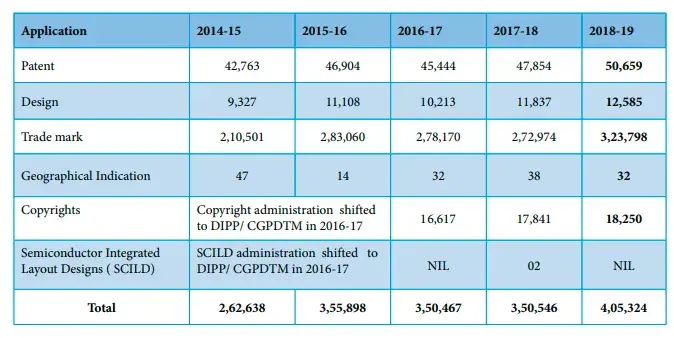
PATENTS
During this year, 50,659 patent applications were filed exhibiting an increase of 5.9% in the filing as compared to the previous year. The trends of last five years in respect of patent applications filed, examined, granted, and disposed are given below. Disposal of applications includes patents granted/refused by the patent office and applications withdrawn and abandoned by the applicants. Further, during 2017-18, the domestic filing has increased to 33.6% as compared to 32.5% in 2017-18.
| Year | 2014-15 | 2015-16 | 2016-17 | 2017-18 | 2018-19 |
| Filed | 42,763 | 46,904 | 45,444 | 47,854 | 50,659 |
| Examined | 22,631 | 16,851 | 28,967 | 60,330 | 85,426 |
| Granted | 5,978 | 6,326 | 9,847 | 13,045 | 15,283 |
| Disposal | 14,316 | 21,987 | 30,271 | 47,695 | 50,884 |
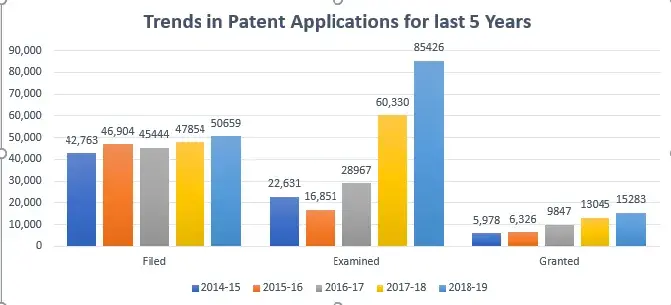
With regards to foreign filing applications the top filing countries are:

DESIGNS
During this year, a total of 12,585 design applications were filed exhibiting an increase of 6.3% over the last year. The number of design applications examined was 12,661 showing an increase of 6.8%. Although the number of design registrations decreased marginally, disposal of design applications increased by 5.8% in 2018-19 as compared to 2017-18.
| Year | 2014-15 | 2015-16 | 2016-17 | 2017-18 | 2018-19 |
| Filed | 9,327 | 11,108 | 10,213 | 11,837 | 12,585 |
| Examined | 7,459 | 9,426 | 11,940 | 11,850 | 12,661 |
| Registered | 7,147 | 7,904 | 8,276 | 10,020 | 9,483 |
| Disposal | 7,218 | 8,023 | 8,332 | 10,788 | 11,414 |
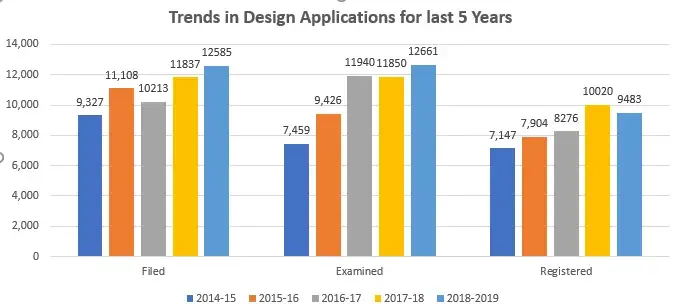
The filing trends of Indian and foreign origin are:
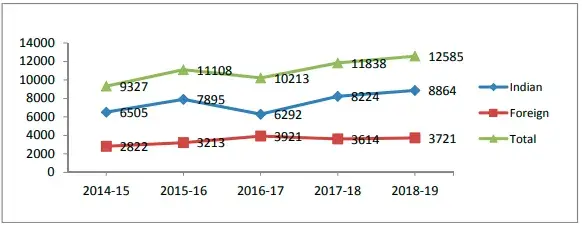
With regards to foreign filing applications the top filing countries are:

TRADEMARKS
During this year, 3,23,798 applications of trademarks were filed. The number of applications examined is more than applications filed during this period and pendency in examination has been brought down to less than a month. The number of trademark registrations showed an increase of 5.3%.
| Year | 2014-15 | 2015-16 | 2016-17 | 2017-18 | 2018-19 |
| Filed | 2,10,501 | 2,83,060 | 2,78,170 | 2,72,974 | 3,23,798 |
| Examined | 1,68,026 | 2,67,861 | 5,32,230 | 3,06,259 | 3,37,541 |
| Registered | 41,583 | 65,045 | 2,50,070 | 3,00,913 | 3,16,798 |
| Disposal | 83,652 | 1,16,167 | 2,90,444 | 5,55,777 | 5,19,185 |
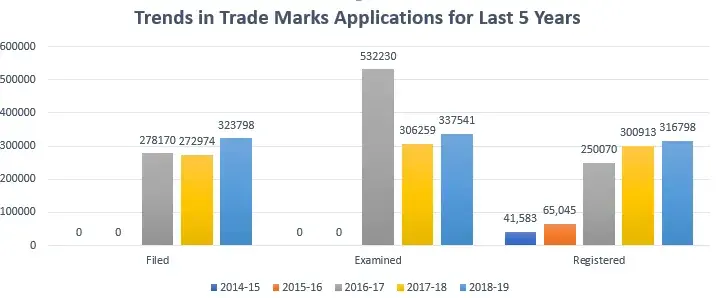
Out of total 323798 applications filed with the Registry; the number of applications filed by foreign applicants during the year was 13682. The top filers are:
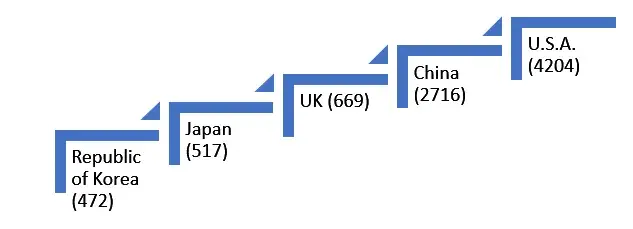
GEOGRAPHICAL INDICATIONS
During this financial year, a total of 32 applications were filed and 35 applications were examined. A total number of 23 Geographical Indications were registered. The trends in GI applications filed, examined, and registered during the last five years are given below.0
| Year | 2014-15 | 2015-16 | 2016-17 | 2017-18 | 2018-19 |
| Filed | 47 | 17 | 32 | 38 | 32 |
| Examined | 60 | 200 | 28 | 18 | 43 |
| Registered | 20 | 26 | 34 | 25 | 23 |
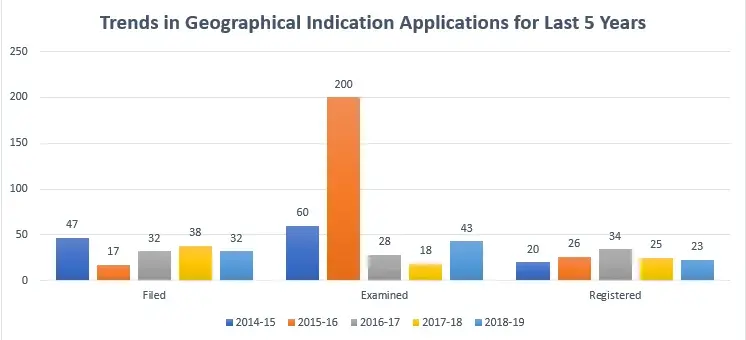
Related Posts
Intellectual Property Appellate Board releases its Annual Report
Direct Selling Companies to ensure compliance under Legal Metrology Act and Rules.

The Deputy Director, Legal Metrology has issued a letter dated September 28, 2020 to the Direct Selling Entities with respect to the compliance of the provisions of the Legal Metrology Act, 2009 and Legal Metrology (Packaged Commodities) Rules, 2011.
In the letter, the Deputy Director has directed that certain mandatory declarations are required to be made on all pre-packaged commodities in the interest of consumers like name and address of the manufacturer/ packer/ importer, country of origin, name of the commodity, net quantity, month and year of manufacturing/ pre-packing/ import. ‘best before or use by date, month and year’ of a commodity which may become unfit for human consumption after a period of time, retail sale price in the form (MRP) Rs…(inclusive of all taxes) and consumer care details.
The Deputy Director has requested compliance of the aforementioned provisions by the Direct Selling Entities and also submit copy of Registration certificate issued under Rule 27 of the Legal Metrology (Packaged Commodities) Rules, 2011.
Legal Metrology Provisions
The mandatory declarations included on pre-packaged commodities as given under Chapter –II- Provisions Applicable to Packages Intended for Retail Sale:
Article l6. Declarations to be made on every package. –
(1) Every package shall bear thereon or on label securely affixed thereto, a definite, plain and conspicuous declaration made in accordance with the provisions of this chapter as to-
(a) the name and address of the manufacturer, or where the manufacturer is not the packer, the name and address of the manufacturer and packer and for any imported package the name and address of the importer shall be mentioned.
(aa) The name of the country of origin or manufacture or assembly in case of imported products shall be mentioned on the package;
(b) The common or generic names of the commodity contained in the package and in case of packages with more than one product, the name and number or quantity of each product shall be mentioned on the package.
(c) The net quantity, in terms of the standard unit of weight or measure, of the commodity contained in the package or where the commodity is packed or sold by number, the number of the commodity contained in the package shall be mentioned.
(d) The month and year in which the commodity is manufactured or pre-packed or imported shall be mentioned in the package.
(e) the retail sale price of the package (Maximum Retail Price)
Rule 27 ‘Registration of Manufacturers, Packer and Importers
Rule 27 provides for the mandatory registration of manufacturers, packers and importers of pre-packaged commodities is deemed mandatory.
In view of thereof, the Direct Selling Entities have to comply with the provisions as enumerated above and accordingly make mandatory declarations on pre-packaged commodity and ensure registration under Rule 27.
Related Posts
Legal Metrology Act, 2009 & Packaging & Labeling Laws in India
LEGAL METROLOGY MEANING IN INDIA
5 Things which you did not know would fall under the legal Metrology Act
Geographical Indications of Goods (Registration and Protection) (Amendment) Rules, 2020- notified.
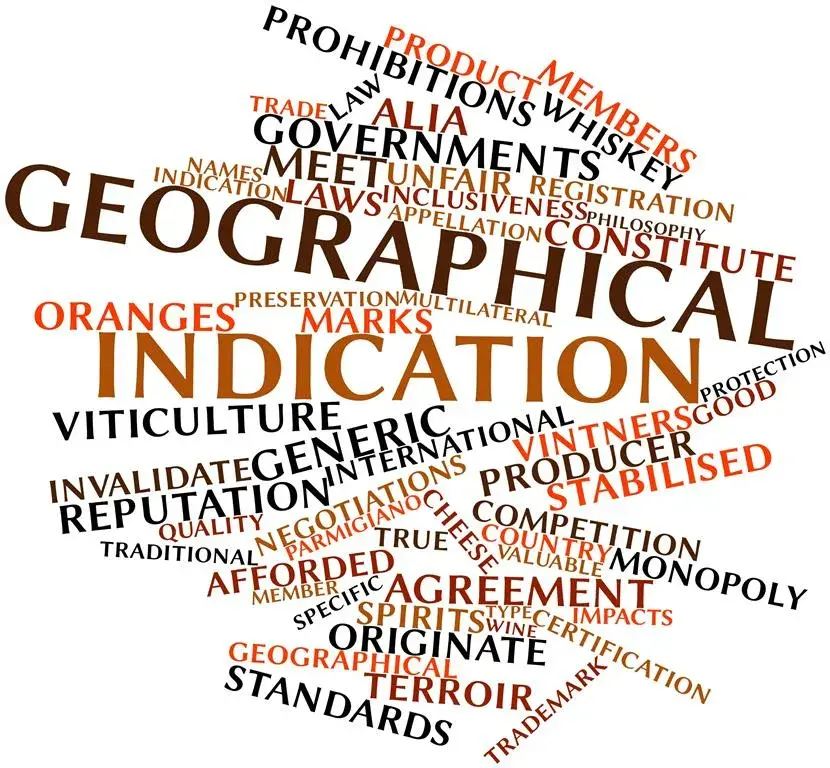
By Pooja Thakur and Ananyaa Banerjee
The Ministry of Commerce and Industry (Department for Promotion of Industry and Internal Trade) vide notification G.S.R. 528(E) dated 26th August, 2020 have amended the Geographical Indications of Goods (Registration and Protection) Rules, 2002. These rules will now be called the Geographical Indications of Goods (Registration and Protection) (Amendment) Rules, 2020 (hereinafter referred to as ‘GI Rules 2020’).
GI Rules 2020- Key amendments
- Only proposed authorized user can file application – The GI Rules 2020 has substituted Rule 56 as:
- Authorised User.-
(1) An application for registration of authorized user under section 17 may be made to the Registrar in Form GI-3 accompanied by a statement of case as to how the applicant claims to be the producer of the registered geographical indication.
(2) A copy of application made under sub-rule (1) shall be forwarded to the registered proprietor of geographical indication and intimate the same to the Registrar.
- Amendment in Rule 59 titled ‘Registration of an authorised user entry in the Register’ – It has amended Rule 59(1). For the registration of an authorized user entry in the register, where an opposition is filed and dismissed the registrar can enter the authorized user in Part B of the register and shall issue a registration certificate with the seal of Geographical Indication Registry. The position before the amendment was that the Registrar had to wait till the end of the appeal period after the opposition is dismissed to enter the authorized user in Part B of the register and the same was to be done with the prescribed fees but the draft amendment rules seek to remove the appeal period obligation along with removal of the fees that is charged currently. Further it amended Rule 59(3) as a result of which the unmounted representation of the geographical indication will now not be required at the time of registration.
- No fees for registration of an authorized user of a registered GI – In Schedule I, under Entry 3A, the fees to be paid for the registration of an authorized user of a registered geographical indication is proposed to be reduced from INR 500 (7 USD Approx.) to INR 10. Similarly, the fees for renewal under Entry 3C of Schedule I is proposed to be reduced from INR 1000 (14 USD Approx.) to INR 10. Further, Entry 3B in Schedule I is deleted to cancel the fees charged for the issuance of certificates.
One of the highlights of the amendment is that it will further strengthen the Intellectual Property Ecosystem as it has reduced the fees to be paid for the GI registration process and has further eased the procedure for registration of an authorized user of the registered geographical indication.
The Geographical Indications of Goods (Registration and Protection) (Amendment) Rules, 2020 can be accessed over here to know more about Notification GI amenmdent rules.
Read more:
Geographical Indications of Goods (Registration and Protection) Act, 1999
Parliament passes Bill to bring Co-operative Banks under RBI Supervision.
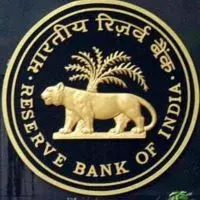
The Banking Regulation (Amendment) Bill, 2020[i] was passed by Lok Sabha on September 16, 2020 and by Rajya Sabha on September 22, 2020. The Bill replaces Banking Regulation (Amendment) Ordinance, 2020[ii] which was promulgated in June, 2020. The Bill seeks to amend Banking Regulation Act, 1949[iii] and bring cooperative banks under the supervision of the Reserve Bank of India (RBI)
Co-operative Banks in India
Cooperative Banks have played an instrumental role in India’s growth and development. These smaller, more localized banks fulfilled banking needs of those for whom branches of Scheduled Banks were inaccessible. People have had immense trust in them because often they are created by persons belonging to the same local or professional community, sharing a common interest with the aim not to maximize the profits but to provide the best possible products and services to its members.
In the recent years, co-operative banks have suffered on account of serious governance issues that resulted in depositors running from pillar to post for their own money. Most prominently at PMC Bank, of its total loan book of Rs 8,880 crore, as on March 31, 2019, about 70 percent had been taken by real estate firm HDIL which is currently facing corporate insolvency resolution process (CIRP) under the Insolvency and Bankruptcy Code. Subsequently, the Bank collapsed and depositors were only allowed to withdraw a maximum amount of Rs. 50,000 from their accounts.
In the year 2019, RBI cancelled the license of CKP Co-operative Bank, Mapusa Urban Co-operative Bank and imposed restrictions on Guru Raghavendra Sahakara (Co-operative) Bank Niyamitha and Kolikata Mahila Cooperative Bank. This year, RBI has put at least 44 co-operative banks across the country under watch citing deterioration in their financials or for flouting prudential norms[iv]. Nirmala Sitharaman stated that during the COVID-19 period, many cooperative banks have come under stress. 277 urban cooperative banks are reporting losses and 105 have been unable to meet minimum regulatory capital requirements[v].
Banking Regulation (Amendment) Bill, 2020- Key Highlights:
- The Bill brings all the co-operative banks under RBI’s umbrella except primary agricultural credit society and co-operative society whose primary object and principal business is providing long-term finance for agricultural development. Thus, Cooperative banks will now be subject to same guidelines as Scheduled Banks with certain exceptions.
- Section 12 of the Bill allows cooperative banks to issue equity shares or preference shares or special shares or unsecured debentures or bonds or other like securities with initial or original maturity of not less than ten years with prior approval of RBI and such conditions as may be specified by RBI.
- Pursuant to Section 10(1)(b) of the Banking Regulation Act, Co-operative banks can no more employ as Chairman, someone who is insolvent or has been convicted of a crime involving moral turpitude or whose remuneration takes the form of commission or share in profits of the bank. RBI may remove the Chairman if he is not fit and proper and appoint a suitable person if the bank does not do so.
- Under Section 36AAA, RBI will now have the power to supersede the Board of Directors of a co-operative bank after consultation with the state government.
- RBI has been the power to exempt co-operative banks from complying with certain provisions relating to employment, qualifications of the Board of Directors and, appointment of a chairman by issuing a notification in the official gazette through insertion of Section 53A in the Banking Regulation Act, 1949.
The amendment addresses rampant governance issues prevalent in cooperative banks that have resulted in losses not only to account holders but erodes confidence of people in the entire banking sector. These provisions bring cooperative banks to similar footing in terms of regulatory oversight as those applicable on Scheduled Banks.
It is expected that the scrutiny and oversight of RBI over cooperative banks will ensure that the money of local communities are protected. The power given to cooperative banks under Section 12 will also allow cooperative banks to raise money, maintain liquidity and recover from the crisis by issuing shares either through private placement or public offer.
[i] https://www.prsindia.org/sites/default/files/bill_files/Banking%20Regulation%20Bill%2C%202020%20as%20passed%20by%20LS.pdf
[ii] https://pibcms.nic.in/WriteReadData/userfiles/PIB%20Delhi/cooperative%20bank%20(2).pdf
[iii] https://rbidocs.rbi.org.in/rdocs/publications/pdfs/banki15122014.pdf
Related Posts
India: RBI clarifies Co-operative societies cannot use the word “Bank” in their names
Labelling Regulations not violated if ‘relevant information’ traceable from Barcode.
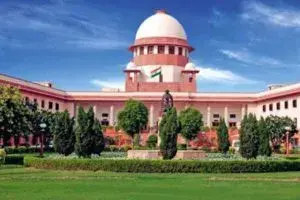
By Vikrant Rana and Priyanka Batra
The Supreme Court of India, on September 04, 2020 gave a landmark judgement concerning the labelling regulations in India. The Apex Court, in the case of, Raghav Gupta v. State (NCT of Delhi)[1], reversed the decisions of the lower Courts’ setting a more practical precedent in the area of food adulteration laws in India.
The three-Judge Bench , comprising of Hon’ble Justice Rohinton Fali Nariman, Justice Navin Sinha and Justice Indira Banerjee, closely interpreted Rule 32(e) of the Prevention of Food Adulteration Rules, 1955 (hereinafter referred to as “the Rules”) framed under the Prevention of Food Adulteration Act, 1954 (hereinafter referred to as “the Act”) wherein it was held that relevant information under Rule 32(e) of the rules with regard to the lot/code/batch number are available via the barcode and quashed the criminal proceedings initiated against Raghav Gupta & Ors.
Prior to delving into the case analysis of the case, one ought to understand the meaning of the term ‘lot / code / batch number” which is defined under section 2 (5) of the Food Safety and Standards (Packaging and labelling) Regulations, 2011: “Lot number” or “code number” or “batch number” means the number either in numericals or alphabets or in combination thereof, representing the lot number or code number or batch number, being preceded by the words “Lot No” or “Lot” or “code number” or “Code” or Batch No” or “Batch” or any distinguishing prefix by which the food can be traced in manufacture and identified in distribution[2].
Rule 32 of the Prevention of Food Adulteration Rules, 1955 reads as follows
- Contents of the label.-Unless otherwise provided in these rules there shall be specified on every label-
(a) the name, trade name or description of food contained in the package,
(b) the name and business address of the manufacturer or importer or vendor or packer,
(c) when any permitted class II preservative and/or permitted colouring agent and/or permitted antioxidant and or vitamin is added, a statement to the effect that it contains permitted class II preservatives and/or permitted colouring agents and/or permitted antioxidants and/or vitamins,
(d) the net weight or number or measure or volume of contents as the circumstances may’ require ,except in the case of biscuits, confectionery and sweets where the weight may be expressed in terms of either average net weight and/or minimum net weight,
(e) a batch number or code number either in Hindi or English numericals or alphabets or in combination
Provided that in the case of food package weighing not more than 60 grams particulars including the statement under any clause need not be specified.
Provided further that in the case of:-
(a) aerated water containers, and
(b) a package containing more than 60 grams but not more than 120 grams of biscuits, confectionery and sweets, particulars under clauses .(d) and (e) need not be specified.
Explanation.-The term ‘label’ means a display of written, printed, perforated, stencilled, embossed or stamped matter upon the container cover lid and/or crown cork of any food package.][3]
The above provision, makes it mandatory to mention all the details of the including but not limited to the name of the manufacturer, batch number of the product, description of the food etc. on the label. A contravention of the said provisions attracts penalty.
In light of the above provision, the Food Inspector in the case at hand inspected the Snapple Juice bottles. The facts of the case are as follows:
Facts of the case:
Raghav Gupta & ors (hereinafter referred to as the ‘Appellants’) directors of M/s V&V Beverages imported ‘Snapple juice drinks’ from United States and supplied to their distributor company, M/s A&M Enterprises, which in turn distributed the same to M/s Barista Coffee Company Limited, the end vendor ((hereinafter referred to as the ‘Respondents’)
On May 3, 2011 food officials including Food Inspector and Field Assistant under the supervision of the Local Health Authority (LHA)/SDM inspected the premises of M/s Barista Coffee Company Ltd., Connaught Place, New Delhi and lifted 6 sample bottles of ‘snapple juice’ which were stored for sale in sealed glass bottles of 473 ml each.
The samples were given to the LHA and the Public Analyst who reported on May 30, 2011 that the product conformed to the standards; however, the sample products were in contravention of the rule 32(e) of the of the Prevention of Food and Adulteration Rules 1955, as amended, as the declaration regarding ‘batch number/ code number’ were missing on the label.
After the report, a complaint was filed against the respondents in violation of Section 2(ix)(k) of the Act along with Rule 32(e) of the Rules, and punishable under Sections 5, 7, 16(1)(a) of the Act.
The Case before the Delhi High Court
Contentions by the Appellant – Delhi High Court:
- The Appellant argued that the sample of the “Snapple” juice was not misbranded as the necessary information as per Rule 32(e) was made available in the barcode, which was sufficient to comply with the requirements under Rule 32(e).
- It further prayed for quashing the complaint and contended that the Respondents failed to show any material as evidence to the fact that the Appellant was responsible for the day-to-day conduct of the business.
- Additionally, it was submitted that the Appellant had already resigned before the samples were seized by the concerned authorities. It was also submitted that scanning the barcode would release all relevant and necessary information about the manufacturer, nature of the product, batch number, etc.
- It was argued that the information by scanning of the bar code is a labelling standard recognized globally and is instituted to make the entire system supply and billing speedy.
Contentions by the Respondent- Delhi High Court
- It was argued that no definition of “batch number” or “code number” has been laid out in the Act or the Rules. Additionally, through literal interpretation of Rule 32(e), the batch number or the bar code ought to be mentioned in Hindi or English or numerical or alphabets or a combination.
Decision of the Delhi High Court:
The Hon’ble Delhi High Court analyzed the language of Rule 32(e) of the Rules prior to 2006 amendment and after it. It held that the distinction is in the purpose of having a batch number or a code number which was missing in the provision before the amendment.
Additionally, the Court held that if the batch number or code numbers of the product is not mentioned on the bill/invoice, then it may be difficult to track the supplier/distributor of a particular product, which may have been found to be misbranded or adulterated.
The Court upheld the decision of the trial court, holding in favor of the respondent and holding that it ought to be essential that the manufacturer/packer mentions a batch number or a code number to his product so as to identify the distribution chain.
The Case before the Hon’ble Supreme Court
Aggrieved by the decision of Delhi High Court an appeal was filed before the Hon’ble Supreme Court. The Appellant submitted that the necessary information as per Rule 32(e) of the Rules was available through the barcode on the product and all information can be revealed by scanning the barcode. The contention could not be countered by the Respondent.
Judgement by the Hon’ble Supreme Court:
The three-judge bench of the Apex Court held that having the barcode is an undisputed fact. What is to be observed is the fact that whether or not the relevant information as per Rule 32(e) of the Rules, which would trace back to the manufacturer. If the relevant information concerning the manufacturer, the product, etc. can be extracted by scanning the barcode labelled on the product, then there is no violation of Rule 32(e) of the Rules or any other regulation in this regard.
The Bench, quashing the orders of the lower courts, was of the opinion that having to take this case ahead would be a sheer waste of time and the barcode is sufficient to trace the relevant information.
Conclusion & Analysis:
The decision of the Hon’ble Supreme Court balances out the modern yet authentic approach of the law. While it is necessary to ensure that the products made available to the consumers are of an optimum quality, it is also necessary to acknowledge the digital age we are living in.
The approach is a more modernized approach and considering the dynamic changing environment, restricting such basic, yet necessary information due to the way of obtaining information, is only a restriction of one’s right to be aware of the relevant distribution chain and other significant information. [4]
[1] Criminal Appeal No. 562 of 2020.
[2] [2]http://dhsr.hp.gov.in/?q=compendium-packaging-labelling-regulations-22012019
[3] http://extwprlegs1.fao.org/docs/pdf/ind10950.pdf
[4] https://indiankanoon.org/doc/61800811/
Delayed Possession- MahaRERA awards Rs. 5 Crore to Allotee.

By Lucy Rana & Shilpi Sharan
Renaissance Infrastructure vs. Parth B. Suchak
Factual Background:
M/s Renaissance Infrastructure, the Respondent herein, is the original complainant (hereinafter referred to as the Complainant) and Parth B. Suchak is the Appellant herein, originally the Respondent-promoter (hereinafter referred to as the Promoter). As per the agreement of sale (“the agreement”) dated December 10, 2009, the Complainant had bought six plots of land along with a warehousing building from the Respondent Promoter. According to the agreement, Promoter was supposed to provide possession of the suit property to the Complainant or allottee by March 9, 2010. It is pertinent to point out that, Complainant and Promoter were originally partners and on Complainant’s retirement from the partnership, his share was compensated by providing the suit property, as per the sale agreement. Subsequently, the Promoter failed to adhere to the conditions enumerated under the agreement and thereby, could not hand over possession of the suit property on time i.e. even after extension of further six months. As per the terms of the agreement, on failure to hand over possession on time, the Promoter would be liable to pay or compensate the Complainant/allottee for loss of rent i.e., Rs. 10/- per sq. ft. per month. Hence, a complaint was filed by the allottee for delay of possession of suit property before the Maharashtra RERA Authority.
RERA’s Order
The adjudicating authority passed the order in favor of the allottee, ordering the Promoter herein to compensate the Allottee/Complainant[1]. The adjudicating officer calculated total compensation amount to be Rs. 5.04 Crores upto June 30, 2018 i.e., till the time of filing of the complaint, including the period of six months extension from the agreed date of possession of the suit property (i.e., 80 months). Thus, the concerned adjudicating authority, by order dated March 20, 2019 directed the promoter to pay Rs. 6,30,000/- per month from September 9, 2010 (i.e., after the grace period of six months, from the agreed date of possession) till handing over the possession of suit property. The concerned authority also ordered to execute a conveyance deed.
Consequently, the Promoter challenged this order before the RERA Appellate Authority, However, the appellate authority, vide it’s orders dated January 9, 2020 and January 24, 2020 upheld the order passed by Maharashtra RERA Authority. The appellate authority held that, Promoter/Appellant herein was a promoter and hence was liable to deposit 50% of the compensation amount as per proviso to Section 43(5) of the Act. In view thereof, the concerned appeal was dismissed, and promoter was directed to pay the said compensation amount to allottee.
Subsequently, the three orders passed by the adjudicating authority and appellate authority dated March 20, 2019; January 9, 2020 and January 24, 2020 respectively, were challenged by the Appellant before the Hon’ble High Court of Bombay.
Bombay High Court’s order
The counsel for promoter/Appellant made the following assertions and challenged the previous orders[2]:
- It was alleged that the Appellant was not the promoter as parties to dispute were partners before and the agreement between the parties resulted in the present complaint. Thus, the agreement in question was not agreement for sale per se, but an agreement in lieu of the Respondent’s share in the partnership with the Appellant. In other words, the said agreement was acted upon to compensate for the shares owned by the Respondent, as he was retiring from the partnership.
- It was also contended by the Appellant that the original averment of the Respondent was pre-mature and Further, the Appellant also contended that the adjudicating officer do not have jurisdiction in the present case as the same was in the nature of liquidated damages.
The Hon’ble High Court of Bombay in view of facts and circumstances of the case and law prevailing on the subject, made the following observations and order in the case:
- The Hon’ble Court noted that as the Appellant was involved in construction of a real estate project and selling of plots and flats, the Appellant was a Promoter. It was further observed by the Court that the agreement entered into between the parties to dispute, clearly enumerated sale of suit property and hence the same was an “agreement for sale”.
- That as per the agreement for sale, promoter/Appellant was bound to hand over possession of the concerned property within the agreed time, i.e., till September 9, 2010 (including 6 months grace period). Reportedly, the promoter failed to adhere to the terms and conditions mentioned within the agreement, consequent to which, promoter was liable to compensate the allottee.
- It was also pointed out by the Court that, consideration of an agreement for sale, instead of money could also be a valuable consideration, including satisfaction of the allottee’s share in the promoter’s partnership. Hence, the present case dealt with allotment and sale of constructed premises with land (i.e., the suit property), in lieu of allottee’s claim and shares in the business/assets of the partnership. It was therefore observed by the Court that the Appellant herein was in fact the promoter and thus the adjudicating authority had jurisdiction over the issue.
- In view of the aforesaid observations, the Court pointed out that, as the Appellant was a promoter, he had to adhere to the proviso to Section 43(5) of the Act and accordingly pay 50% of the compensation as a condition precedent to filing an appeal. Thus, the Hon’ble Bombay High Court found no infirmity and illegality in the impugned orders passed by adjudicating authority and upheld the same.
The Court thereby dismissed both the appeals and directed the promoter to pay half of the compensation as directed by the adjudicating authority, within the stipulated time of 4 weeks and further instructed that no sale shall of the suit property shall take place until payment of compensation and failure to comply with the order would authorize the concerned tehsildar to commence sale of suit property.
Delayed possession of flats and compensation under RERA
The delayed possession of flats or plots to home buyers has emerged as one of the most crucial issues in the Real Estate sector in India. In the past few years, home buyers have several times approached Courts and Tribunals with the grievance of delayed possession of flats by promoters and developers.
Prior to 2016, lack of any specific law governing the Real estate sector in India rendered home buyers helpless and handicapped in such circumstances of delayed or non-possession of flats even after paying the entire consideration as per the terms of development agreement. However, the enactment of Real Estate (Regulation and Development) Act, 2016 and judiciary’s stringent approach against such builders has helped in contouring the law and legal implications pertaining to delayed possession of flats by promoters/builders in India.
[1] MANU/RT/0001/2020
Can Ex-employee of Financial Creditor be Interim Resolution Professional?
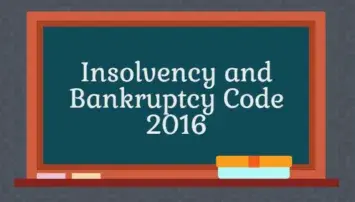
By Lucy Rana and Anuj Jhawar
State Bank of India v. M/s. Metenere Limited[1]
In a recent case, the National Company Law Appellate Tribunal (“NCLAT”), vide its ruling dated May 22, 2020 upheld the order passed by respective National Company Law Tribunal (“NCLT”) dated January 4, 2020 with respect to substitution of appointment of an ex-employee of the Financial Creditor as the Interim Resolution Professional (IRP).
Factual Background
In the present appeal, State Bank of India is the Appellant (“Financial creditor”) and M/s Metenere Limited is the Respondent (“Corporate Debtor”). Appellant had furnished an application under Section 7 of Insolvency and Bankruptcy Code, 2016[2] (“Code”) for initiation of Corporate Insolvency Resolution Process (“CIRP”) against the Respondent. The Appellant had nominated one of its ex-employee, who worked in the Appellant Bank for 39 years, to be appointed as the IRP for insolvency proceedings against the Corporate Debtor. Aggrieved by IRP’s proposed appointment, the Corporate Debtor or Respondent objected the same on the ground that the appointment of IRP was partial and biased.
NCLT’s Order
In view of the aforesaid objection made by the Corporate Debtor, the concerned NCLT vide its order dated January 4, 2020 ordered and directed the Financial Creditor to substitute IRP as the he had worked for Appellant bank for 39 years straight, thereby subsequently creating apprehension of bias and unlikely to render fair and unbiased services.
Hence, the Financial creditor was ordered substitution of IRP.
Appeal before NCLAT
Aggrieved and dissatisfied with the order passed by NCLT, the Financial Creditor appealed before the NCLAT on the ground that the concerned and proposed IRP fulfilled the requirements, eligibility and qualification as enumerated in the Code and thus, should be appointed as the IRP.
Issue- Whether an ex-employee of Financial Creditor can be appointed as an Interim Resolution Professional?
NCLAT’s Order and Observations
- Relying on Regulation 3(1) of Insolvency and Bankruptcy Board of India (Insolvency Resolution Process for Corporate Persons) Regulations, 2016[3](“Corporate Persons Regulations”); NCLAT considered such nomination of IRP appointment as valid and legitimate. The Tribunal observed that merely because a nominated IRP was an employee of Financial Creditor did not disqualify him/her and did not make him/her an interested and biased person. The Tribunal also stated that as per the regulations, an IRP should independent of any relation with Corporate debtor and not Financial Creditor.
- NCLAT also relied upon the case of State Bank of India v. Ram Dev International Limited[4] wherein it was observed that, even if an IRP is acting/working as an Advocate , Company Secretary or Chartered Accountant with the ‘Financial Creditor’, such a proposal for appointment couldn’t be disqualified merely on such employment basis, except, when there is any disciplinary proceeding pending against him/her or if that person is an interested party, such as an employee or on the payroll of the ‘Financial Creditor’.
- The Tribunal noted that in the present case, the proposed IRP was neither undergoing any disciplinary proceedings nor not on afore stated panel or engaged as a retainer by the ‘Financial Creditor’ but was merely a pensioner as he had rendered his services to the Appellant Bank for almost four decades.
- The Appellate Tribunal also made reference to Section 17(1) of the Income Tax Act, 1961 and opined that bringing pension within the ambit of ‘salary’ could not be interpreted to render a pensioner of a ‘Financial Creditor’ under the statutory framework ineligible as an ‘interested person’ being in employment of the ‘Financial Creditor’ as the definition of ‘salary’ under the Income Tax Act, 1961 is designed only for the purposes of computing of income to determine tax liability.
- However, the Tribunal could not avoid taking note of the fact that in the present case, the Appellant chose to propose its ex- employee, namely, Mr. Shailesh Verma as ‘Interim Resolution Professional’ in view of his past loyalty and long services rendered to the Bank. The NCLAT while making this observation further noted that its view was further reinforced in view of the present appeal initiated by ‘Financial Creditor’ as the Appellant Bank was aggrieved by NCLT’s order directing substitution of IRP.
- The Appellate Tribunal also on the case of Ranjit Thakur v. Union of India and Ors[5] wherein, the necessity for a test of apprehension of bias was considered in order to ascertain the probability of impartiality, unfairness and bias.
In view of the aforesaid facts and circumstances, the NCLAT ruled that the apprehension and disregard expressed by Financial creditor in the present case could not be overlooked and hence dismissed the appeal.
Conclusion
The order of NCLAT in the present case is an essential one as the Tribunal though judged the Financial Creditor’s ex- employee as an eligible IRP under the Code but refused to appoint him as IRP, as the Financial Creditor’s grievance for not appointing its ex-employee as IRP in the case was evident and hence did not pass the test of apprehension and bias.
[1] MANU/NL/0241/2020
[2] https://www.mca.gov.in/Ministry/pdf/TheInsolvencyandBankruptcyofIndia.pdf
[4] https://nclat.nic.in/Useradmin/upload/17783526875b6a8fe536213.pdf
[5] MANU/SC/0691/1987
Related Posts
India: Role of Insolvency Resolution Professionals appointed under IBC
IBBI strengthens norms over Insolvency Resolution Professionals (IRP’s)
Impleadment of MCA in every Insolvency and Company matters not mandatory- NCLAT
USA’s Legislative Proposal to redefine Intermediary Liability

By Bijit Das and Isheta Srivastava
Introduction
In last few years, there has been a steep growth of various forms of digital media like social media, e-commerce entities, internet service providers, etc. This change has given a new outlook to the legal landscape related to the duties, rights, and liabilities of these internet platforms. Today one of the most discussed legal issues across the globe is related to defining the parameters of liability of internet intermediaries.
Internet Intermediaries in simple words can be understood as organizations that bring together or facilitate transactions between third parties on the Internet.[1] With regards to its liabilities, initially most of the jurisdictions provided umbrella protection to the intermediaries considering they were just providing a platform for any kind of transaction to happen, though, this protection had some limitations.
However, with time the role of intermediaries has also evolved, and internet has also expanded its horizons. Due to this, the intermediaries are now more involved and are becoming a part of the transactions that happen on their portal. Also, the intermediaries are used as a platform to voice opinions or to express one’s creativity which may sometimes cross the boundaries of legality. In such a scenario, many jurisdictions are now reinterpreting the parameters of intermediary liability.
Redefining Intermediary Liability in USA – A Legislative Proposal reforming Section 230
As per reports, in a recent move, the United States Justice Department has recently recommended a legislative proposal seeking to reform legal immunity for internet companies[2]. The intention behind the proposal is to expand the accountability of internet intermediaries and make them more responsible regarding the subject matter of their platforms.
Currently, Section 230 of the Communications Decency Act provides legal immunity to the intermediaries in US. The sub clause (2) of the section states that[3]:
No provider or user of an interactive computer service shall be held liable on account of –
(A) any action voluntarily taken in good faith to restrict access to or availability of material that the provider or user considers to be obscene, lewd, lascivious, filthy, excessively violent, harassing, or otherwise objectionable, whether or not such material is constitutionally protected; or
(B) any action taken to enable or make available to information content providers or others the technical means to restrict access to material described in paragraph (1).
The core purpose of Section 230 is to protect the owners of any “interactive computer service” from liability for anything posted by third parties. The idea was that such protection was necessary to encourage the emergence of new types of communications and services at the dawn of the Internet era.[4]
As per reports, this step was taken after the allegations of potential breaches of antitrust law, infringement suits against several big entities in US, including search and advertising giant, e-commerce giant etc.
The legislative proposal has suggested a series of reforms to ensure internet companies are transparent about their decisions when removing content and when they should be held responsible for speech they modify.[5] It also revises the existing definitions in Section 230 with more concrete wording that offers more guidance to users and the courts, and encourages online platforms to fight against illegal content and pushes for more clarity on federal actions of civil application.[6]
Attorney General William Barr said in a statement the administration was urging “Congress to make these necessary reforms to Section 230 and begin to hold online platforms accountable both when they unlawfully censor speech and when they knowingly facilitate egregious criminal activity online.”[7]
Intermediary Liability in India
The regulation of intermediaries in India gained momentum during early 90s, with the dawn of internet. The legal responsibility of an intermediary in India has traveled a journey, which started with an umbrella protection from any kind of liabilities.
Section 79 of the Information Technology Act, 2000 provides expansive protection (safe harbor) to intermediaries for third party content as long as they had no knowledge of its illegality or exercised due diligence. Further, in 2008, the amendment to information technology act made it mandatory for intermediaries to exercise due diligence to get protection under Section 79 of the Act.
In India, the jurisdiction related to intermediary liability is still at a nascent stage and is currently being interpreted on a case to case basis.
Conclusion
Though for the legislative proposal by the United States Justice Department to become a law would need congressional approval. It would be interesting to see how the legal landscape of internet intermediaries with progresses across jurisdictions and the balance between the intermediary protection and liabilities is struck.
Read more about intermediary liability below:
Intellectual Property Infringement and Intermediary Liability
Intermediary Liability in India
Intermediary Liability: SC says Intermediaries not protected under section 79 of the IT Act
Regulation of intermediaries in India
[1] https://www.igi-global.com/dictionary/intermediaries-in-e-commerce/53306
[3] http://www.columbia.edu/~mr2651/ecommerce3/2nd/statutes/CommunicationsDecencyAct.pdf
[6] https://newstube.co.in/us-justice-department-proposes-changes-to-internet-platforms-immunity/



